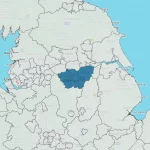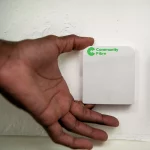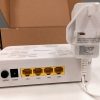Openreach Raises Prices on Copper Lines to Boost UK Fibre Broadband Adoption

Openreach has today announced above inflation price hikes on some of their older copper-based line products for UK internet and phone providers, which are designed to “encourage” comms providers to upgrade their customers to “digital alternatives” and full fibre (FTTP) technology; before legacy services are switched off in January 2027.
Just to recap. The legacy phone switch-off was last year delayed to 31st January 2027 in order to give broadband, phone, telecare providers, councils and consumers more time to adapt (details). The main focus of this was the 1.8 million UK people who use vital home telecare systems (e.g. elderly, disabled – vulnerable users), which aren’t always compatible with digital phone services because telecare providers were slow to adapt. But this overlooks that, for everybody else, many providers will still be working toward the original Dec 2025 deadline to have their customers off the PSTN network.
Suffice to say that today’s change relates to that process, as well as the more distant future withdrawal of other copper-line products and services. Openreach thus intends to introduce wholesale price increases on four of its copper-based products – which will see “prices double in the final three months” before the PSTN – the old system used for landline calls – is switched off.
Advertisement
Rental prices for Openreach’s Wholesale Line Rental (WLR) basic product and other WLR variants, will increase by 20% from April 1st 2026, followed by a huge 40% rise, on the current price, in July 2026, and rising by a further 40% in October 2026, double the current rental price.
Price increases
- On 1 April 2026 the WLR basic rental price will rise from the current price of £10.65 + vat by 20%. The rental price will also rise for other WLR variants
- On 1 July 2026 the WLR basic rental price will rise by 40% of the current price. The rental price will also rise for other WLR variants
- On 1 October 2026 the WLR basic rental price will rise by a further 40% of the current price. This will be to double the current rental price. The rental price will also rise for other WLR variants.
However, at the same time Openreach is adding to a number of existing migration incentives by launching a connection special offer, which will provide a free or discounted connection for providers who upgrade their customers to SOGEA – an alternative copper-based service providing a digital broadband line (i.e. FTTC / VDSL2) where full fibre (FTTP) is not yet available.
Connection offer
- This offer will be for:
- WLR solus (a standalone voice-only service, typically used for traditional landline calls, Alarm systems or emergency lines and low-usage or legacy voice-only customers)
- WLR+SMPF (Provides ADSL broadband over a WLR line. It allows two different providers to share the same copper line: One for voice, via WLR, and one for broadband, via SMPF.
- WLR+FTTC lines (WLR providing voice service over a copper line and broadband over Fibre to the Cabinet) using a migration journey to SOGEA.
- The connection fee will be reduced to zero for non-appointed journeys and discounted for a SOGEA managed install.
Vulnerable users
Last month saw Openreach remove another big barrier to the UK’s transition away from the PSTN, with the launch of its telecare migration service – Prove Telecare, a special migration service that enables telecare users (often elderly or vulnerable people) to move to digital phone lines without losing access to their life-saving devices.
The new measures are being brought in as digital migration rates need to accelerate to ensure no end customers are left on the PSTN by the end of January 2027. “There are currently around three million lines that need to be upgraded to digital alternatives before the deadline – with a conversion rate needed of around 47k every week,” said Openreach.
Advertisement
However, it is predicted that lines could still be left after the 2027 deadline, with some supporting vulnerable customers and Critical National Infrastructure (CNI). To help upgrade remaining lines, Openreach plans to move these customers to an emergency voice-only service which is not reliant on the PSTN – but which can emulate PSTN-like features to support legacy equipment. The ‘no frills’ service will offer a very limited and basic feature set, beginning on 1st February 2027 and continuing until all customers are moved, with the precise timing depending on the volume.
The above paragraph reflects the “temporary” SOTAP for Analogue solution, which is an exchange-based IP-voice service that replicates how the old service worked, albeit over a more modern network (i.e. it does NOT require broadband, new kit, an engineer visit or battery back-up to function). But this is only available as part of migrations and likely to be retired once they start the mass shutdown of old exchanges after 2030.
James Lilley, Openreach’s Managed Customer Migrations Director, said:
“We need to accelerate the pace of migration to ensure no customer is left behind. These price adjustments are designed to drive action, while our special offers help make the transition smoother for everyone.”
With the PSTN switch-off now just over a year away, we’re making these changes to send a clear signal – Communications Providers must act now to move customers – we are reaffirming the deadline for closure, and with the wide availability of full fibre and digital alternatives – providing greater reliability, speed, scalability, and a host of other benefits to both businesses and consumers – there’s no real reason not to.”
Just a reminder that any prices mentioned above only reflect the wholesale rates for communication providers, which are generally not the same as consumers pay at retail because such providers have to add all sorts of extras on top (e.g. 20% VAT, profit margins, network features, services etc.).
Otherwise, most of those likely to be impacted should already be in a location that has access to either reliable FTTP or one of the more modern copper-based digital alternatives (SOGEA), which are supported by almost all the major providers (if you plug your home phone into the back of a router then you probably already have it). For many consumers, the migration may actually save them money, particularly if they take the opportunity to switch to a better deal at the same time.
Advertisement
However, some non-vulnerable users will probably miss a few of the old service’s features, such as the ability to plug in a basic analogue handset and make phone calls during power cuts. But many ISPs do offer battery back-up solutions to achieve a similar result with the newer digital services (or you can buy your own for more capacity), but these will only last a few hours; enough to cover the majority of typical outages.
Mark is a professional technology writer, IT consultant and computer engineer from Dorset (England), he also founded ISPreview in 1999 and enjoys analysing the latest telecoms and broadband developments. Find me on X (Twitter), Mastodon, Facebook, BlueSky, Threads.net and Linkedin.
« Survey Claims 41 Percent of UK People Hit by Broadband Outages
Advertisement
Leave a Reply Cancel reply
Privacy Notice: Please note that news comments are anonymous, which means that we do NOT require you to enter any real personal details to post a message and display names can be almost anything you like (provided they do not contain offensive language or impersonate a real person�s legal name). By clicking to submit a post you agree to storing your entries for comment content, display name, IP and email in our database, for as long as the post remains live.
Only the submitted name and comment will be displayed in public, while the rest will be kept private (we will never share this outside of ISPreview, regardless of whether the data is real or fake). This comment system uses submitted IP, email and website address data to spot abuse and spammers. All data is transferred via an encrypted (https secure) session.





















































If they can emulate PSTN why do they need the delay to 27 or is that emulation difficult expensive?
Due to future exchange closures, the preference is still a migration to digital/FTTP rather than the temporary solution. But it’s taken them time to develop and test the temporary solution and, since we’re talking a few million users, then they have to allow time for gentle / natural migrations too. Resources are finite and have to be carefully managed.
Thanks
Good to see Openreach are finally starting to make it cost-ineffective for ISPs to continue hosting customers on legacy technology and trying to force them to start migrating as soon as they can, before the cost increases come into effect. Hopefully this leads to more SOGEA and/or FTTP that they probably have access to.
So when I’ve got landline (WLR?) from BT, and broadband (FTTC) from Zen, is either of them going to pro-actively contact me to suggest/make the change? I phoned BT the other month and they were keen to get me to move my broadband to them and have digital voice (I don’t want my broadband with them), or said to do nothing and “Openreach” will contact me when the time comes, with talk of battery backup unit and all sorts of things.
I’d gladly get rid of my landline, but none of the mobile operators offer a strong enough signal to even send text messages or make calls when my internet (wifi calling) is down, either the internet down or a powercut, so I’m hesitant to do anything and can see I’ll be in the same position come January 2027 if neither provider takes the first step to do something before?
This is a massive catch 22 as if you move the landline you risk stopping the broadband service. Even if both landline and broadband are with Zen there appears to be no way to port the number to someone such as AAISP without ending the Zen service (this was confirmed to me by Zen).
Then of course there is the issue of having to potentially replace routers etc even though those will need replacement again in a year or two if/when fibre actually becomes available.
You move your broadband from ADSL/FTTC to SoGEA or FTTP if available. If you’re on ADSL and neither SoGEA or FTTP is available then you move to SOADSL. Doing this will cease your current voice service but you then have 30 days to port the number to a VoIP service running over your data-only connection.
My next door Neighbour was getting their telephone from BT and their ADSL2+ Broadband from TalkTalk and was paying through the nose for it.
They went with TalkTalk for everything and stayed on FTTC, even though they had access to WBC-FTTP, as they didn’t want their house to have holes drilled in it. They are not in a priority Exchange, so they could still select to take a VDSL2 based service.
Because TalkTalk has their own telephone equipment within the exchange, the telephone number was ported to TalkTalk and is still delivered over the copper telephone line. TalkTalk Analogue Telephone lines are not effected by the WLR closure.
https://community.talktalk.co.uk/t5/Our-Blog/Copper-Telephone-Network-Switch-Off-What-does-it-mean-for-you/ba-p/2988498
TalkTalk sent out a new VDSL2 router, which was installed while the ADSL2+ connection was in place and it automatically switched over to VSSL2, when the change over was made, the download speed and upload speed is now about 5.5 times faster than the old ADSL2+ connection.
In my honest opinion here I think you’re being a bit of a devils advocate. Whilst I don’t know your personal circumstances based on what you’ve said. You could go onto VOIP with a SOGEA connection with a battery backup. Either provided free by the ISP or you may have to pay for it.
Having separate providers for PSTN and BB now a days is a rarity and I don’t see the Stop Sell being held hostage for what’s likely a very few customers who are either unaware or avoidant on the issue.
There are several options available to you mentioned on the Zen website.
“TalkTalk Analogue Telephone lines are not effected by the WLR closure”. Ditto Sky for that matter, they use LLU too.
“There are several options available to you mentioned on the Zen website.”
Zen can’t officially (or it seems unofficially) provide a landline service if you use your own router, which is their entire USP. Porting the analogue line elsewhere kills the broadband. Catch 22 until fibre arrives.
“There are several options available to you mentioned on the Zen website.”
There are, however as an end user, I have no idea if it’s “broadband supplier” or “landline supplier” that I expect to hear from or who I have to contact. The advertising (aimed at a different group of people, admittedly) a few months ago suggested calling the landline company I seem to remember, so that’s what I did the other month, just to get a sales pitch from BT, or what seemed like a bit of a fob-off of wait (of course that’s good for them, the longer they can string out the landline billing before they lose me) until “Openreach” (who I didn’t think was customer facing as such?) gets in contact with me.
I do realise I may be in a fairly small(?) group of people who have this setup of one service from one provider and one from another – it’s been that way, with various ISPs but just BT for landline, since 2001 and never had the two bundled together, for the reason I didn’t want the two services linked/wanted freedom to move either, but now it appears doing something with one or the other could cease the other anyway…?
This is the thing, I don’t understand who’s going to take the proactive step. ISP Zen, Landline BT, Myself – and if it’s myself, what do I have to ask for/get right – as another person has noted, and I’ve read elsewhere, there’s a risk it’ll cease my broadband, and there’s no way I want that, I’d rather sit it out until Jan 2027 and find the landline just goes dead and (at then) cease that part instead.
“Zen can’t officially (or it seems unofficially) provide a landline service if you use your own router”
I do use my own router, I’m not too fussed about a landline so could go without, but I don’t want to find my broadband gets ceased just because I ditch the BT home phone service (but would save a fortune doing so in the long run, as it hardly ever gets used now)
Candidly, my rural property might as well be on the moon as far as BT OpenReach is concerned. I could live with a long date for rolling out fibre broadband, but I can’t even get that. “No current plans” is the constant refrain. I am going for Starlink.
What if you have ADSL and no FTTC or FTTP?
Does your bill get hiked up?
Only having ADSL available isn’t an issue.
Yes. That is the WLR+SMPF option listed in the connection offers, so will increase in price until WLR is withdrawn and the service ceased.
The migration path would be to SOADSL (equivalent of SOGEA for FTTC), plus a VoIP / Digital Voice service. You may be hard pressed to find providers offering it as the number of premises with no SOGEA or FTTP available is small.
Makes me laugh house visit, pavement marked up and garden by Openreach date given. Waited in called EE, nobody installing today, 15.00 hrs Openreach appear to mark up ready, amazed to see its all ready done. Apparently 1st order cancelled, given another date then another date over 3 months from signing up with Openreach now December. Waiting on council for permit local council BCP have no requests for pavement work im informed. Openreach can’t complete a small job, no wonder we are falling behind
I’m in a block of flats in London, with FTTC. No sign of Openreach rocking up here, and no timescale. BT and maybe Openreach are conflating PSTN switch off with full fibre sales.
Meanwhile my freeholder landlord allowed an altnet to come and drill thought the fire compartmentalisation to install fibre in the block. Ugh
Not sure how they’re conflating anything.
The FTTC network has no defined closure date as it is not reliant on PSTN or a local exchange that may be on the closure list. If your ISP actually is BT, they’d eventually move you to SOGEA (FTTC without PSTN) and you can choose if you’d like to keep the landline number on their Digital Voice service.
If FTTP is available and it is not in a stop sell area, BT will probably push you to upgrade as part of that changeover, but it isn’t an Openreach requirement that they do so. It becomes a requirement in a copper stop sell area.
So there’s a gap for those people who live in a stop sell area but you can’t get permission to have it installed. You could end up having your 80Mbit FTTC downgraded to 40Mbit SOGEA as this is the only path Openreach allow in those cases when the computer says yes to FTTP.
Other ISPs may have different policies but still have to adhere to the Openreach rules. If they don’t use the Openreach WLR product (eg TalkTalk and Sky who use their own equipment to provide analogue phone service) then the 2027 shutdown and these price rises do not apply to them, but they will have to get ready for exchange closure.
Is there an easy and quick way to determine if a specific line/property is on a WLR based solution or SOGEA/SOADSL/SOTAP (or indeed FTTP)?
e.g. by interpreting the output from BT wholesale broadband checker?
For example, if you are moving to a new house, or just want to check to support a neighbour/relative through the transition.
The whole thing about potentially loosing access to a landline number worries me, especially if you have a well known number printed on business cards. It’s the sort of thing that should have been sorted out at part of OTS. Whats the best migration path to go from existing services to digital voice while maintaining a number (same supplier or changing supplier under Openreach or to an alt-net/3rd party VoIP supplier).
NB: my only local alt-net wants to charge £10 pm for VoIP on top of their FTTP, something I have bundled with my Sky FTTC/VDSL (non VoIP or VoIP) today for no extra charge. Ripoff.
The BT Wholesale checker doesn’t tell you if there is an active copper line or what service it is providing, it does however show if a FTTP ONT is fitted and also if it is active.
OTS completely ignored the scenario where someone wishes to split an active FTTC service to SOGEA and VoIP with different providers.
I think there have also been posts where people on FTTP have been told by their suppliers that they can’t port their DV number without it ceasing their broadband, despite their being no technical reason for this (unlike the FTTC scenario).
The safest way is to order a new broadband-only service (either Openreach or altnet FTTP), then once installed port the PSTN number to a VoIP provider which will cease the FTTC (or SOGEA + DV) line.